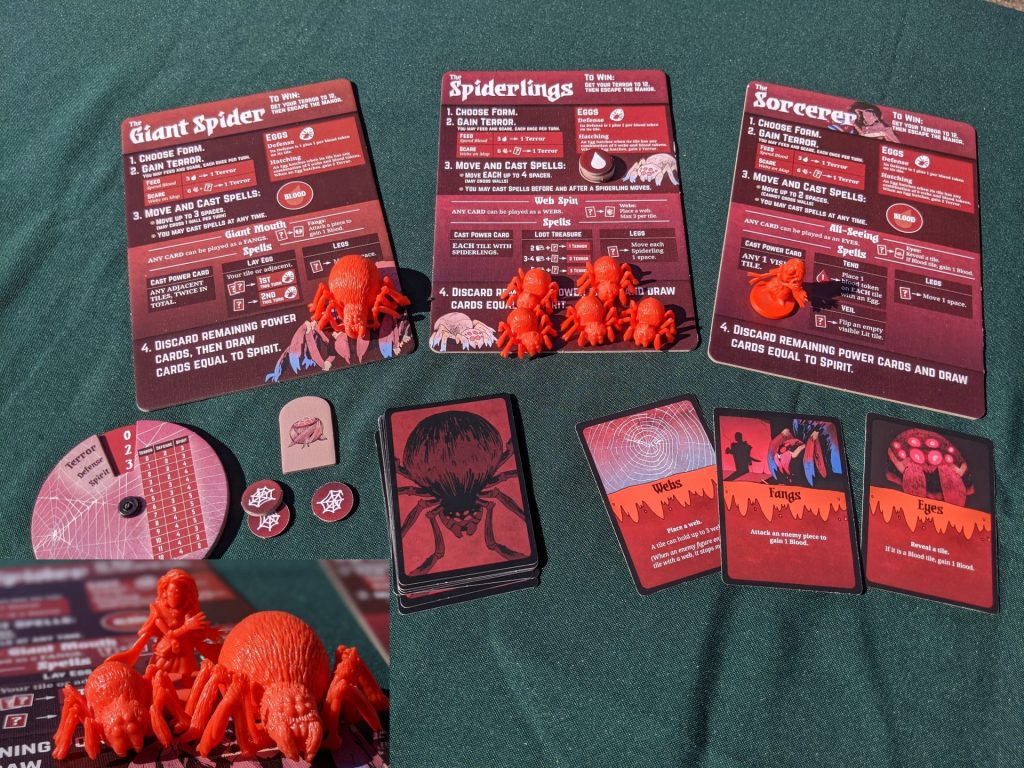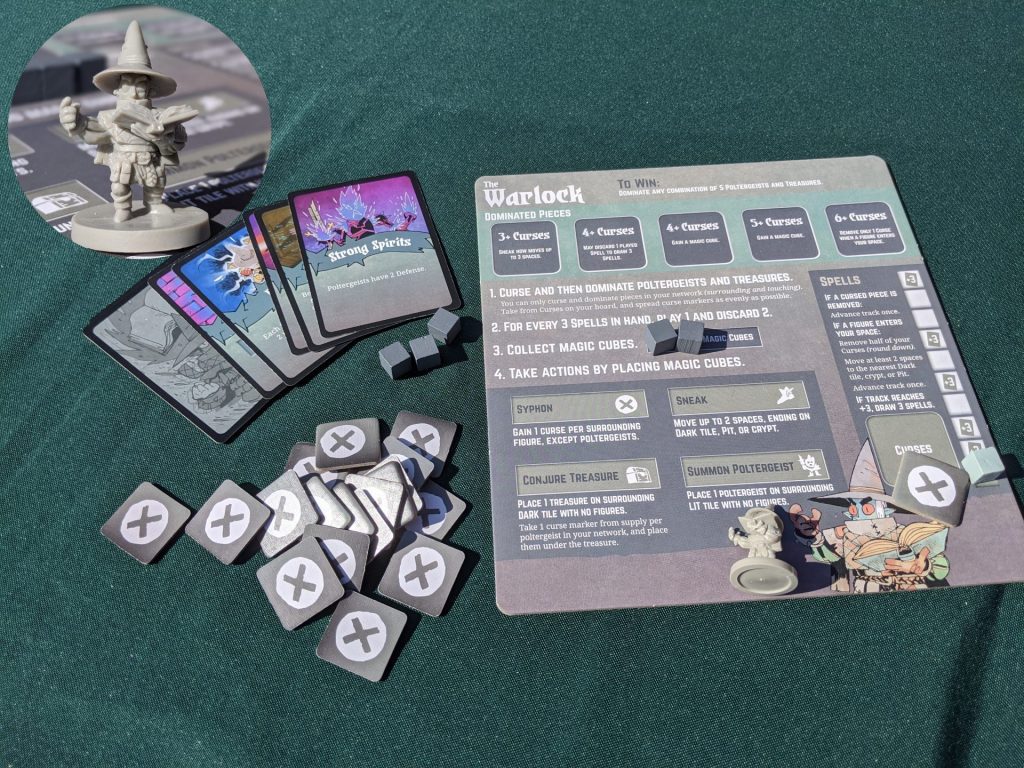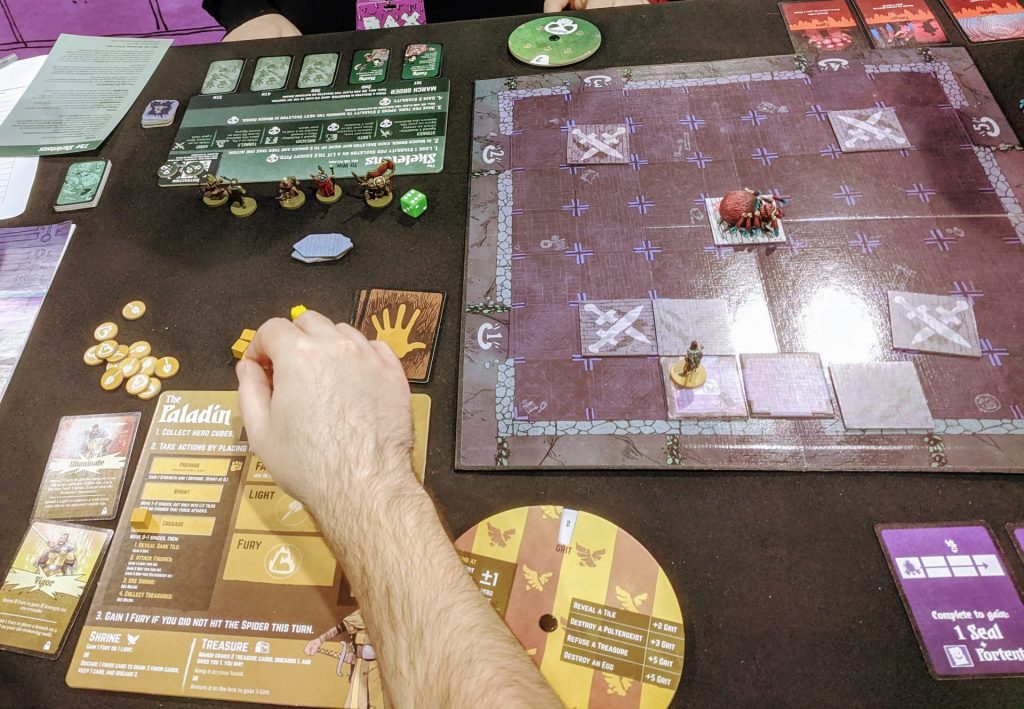Vast: The Mysterious Manor is an ambitious game, whether you approach it from the designer’s perspective or the player’s. Vast: The Mysterious Manor is a return to the world and asymmetrical gameplay of Vast: The Crystal Caverns. Both are developed and published by Leder Games, more famously known for publishing Root. Seeing the greater success of Root in 2018, Patrick Leder utilized the help of Cole Wehrle to design a Vast game with the same polish as Root. The goal was to make a game that is easier to learn and quicker to play than Vast: The Crystal Caverns. What he designed is a set of 5 different games that have interlocking pieces that fit just so — and generally work well together once you understand the puzzle. As a player, you have a couple of choices of approach: either learn all 5 games to a degree that allows you to maximize your strategy each turn OR only learn your own role and just enough of the other roles to not make any huge mistakes, while hoping no one really understands what you’re going to do next.
Such a complex game has great potential to be the most rewarding game in your collection…but with a very steep learning curve, it also has the potential to scare away many players.
Due to the complex nature of this game, I want to avoid covering as much gameplay as I have for other games. I encourage you to read the living rules set from Leder Games’ website if you want to know specifics. Don’t rely on any overview or video to know the rules of this game. Its complexity lends itself to too many false assertions and conclusions.

Theme
The story and lore of Vast: The Mysterious Manor is that there’s a mysterious Manor that lures in unsuspecting beings from the world and tries to trap them for eternity. Because it’s lonely.
Somehow the Manor trapped a Spider who is now trying to escape by terrifying all the newcomers, which helps it grow in power so that it can breach the magic of the Manor.
The Paladin followed the Spider in and seeks to end its life for the glory of his gods, not realizing that he has made it possible for the Spider to escape.
The Skeletons seek to kill the Paladin. No reason is given. The skeletons are a group of 5 different skeletons named Casty, Screamy, Shooty, Slashy, and Stabby, each with their own corresponding look and abilities.
The Warlock seeks to syphon the power of the others to dominate a combination of poltergeists and treasures. Apparently they enjoy risk taking but are completely afraid of face-to-face confrontations.
Kyle Ferrin’s artwork is pleasing and intriguing to the eye. The game comes with miniatures for some of the figures but each miniature has a cardboard equivalent if you somehow prefer cardboard. At a minimum, the cardboard gives miniatures painters a palette guide.

Gameplay
Most of this review assumes a game of 5 players. However, the game also allows for player counts of 1 to 4. There’s a one player solo mode for the Paladin. At two players, the Spider can be pitted against either the Paladin or the Skeletons. At three players, there are rules for 5 different combinations. Finally, at 4 players, either the Warlock or the Manor sits out. Other combinations are being developed and tested per a Reddit AMA.
Vast: The Mysterious Manor can also be mixed and mashed with Vast: The Crystal Caverns; there are rules for taking Mysterious Manor roles to Crystal Caverns and vice versa. This review won’t tackle those options, but know they exist.

The Shared Rules
While there is a base set of rules that all factions follow, the bulk of the game is asymmetrical. First, the shared rules:
- everyone has at least one figure that gets moved around on the manor board
- whenever someone reveals a tile, they must place at least one open edge adjacent to another open edge
That’s it. Someone super sharp might find another small rule or two, but that’s practically it. Every other rule in the game has a faction with an exception or change for how they interact with it. For instance, the Paladin can only walk on dark and lit tiles, never crypts or grounds; the Skeletons can walk everywhere; the Spider has three forms but can only traverse dark and lit tiles but can also cross walls in some forms; the Manor’s avatar is a wraith that can only move among the dark and lit tiles but ignores walls; and the Warlock can go everywhere but the grounds, also ignoring walls.
What you really have, despite the shared rules and map, is 5 different games that intersect in interesting but ever-changing ways.

Faction Play Overview
The order of play is always the same, starting with the Paladin. The gameplay discussions assume regular difficulty, but be aware that you may choose different levels of difficulty per player which will change the rules below.
The Paladin wins by killing the Spider. He must strike the Spider 5 times. To be successful, he must explore the manor, kill other figures, collect treasure, and acquire new abilities.
The Skeletons win by killing the Paladin, striking him 7 times. To do so, they must loot treasure, arm themselves with additional equipment, and manipulate their Marching order to surround the Paladin. Each time a Skeleton strikes, successfully or not, he goes to the front of the Marching order, giving you some interesting decisions to make regarding tactics. You build and then solve a timing and movement puzzle.

The Spider wins by growing in terror and escaping the manor. It must grow its Terror from 0 to 12. The Spider spends blood obtained by attacking, hatches eggs (with blood/webs), or fills the manor with cobwebs to grow Terror. The Spider has three forms with varying abilities and is ultimately limited in action by the deck of action cards it draws from.
The Manor wins by placing 14 Seals that it acquires via Rituals. Each Ritual awards the Manor with 1-3 Seals. The Manor completes Rituals by moving its semi-physical form, a wraith, through unobstructed hallways of the manor. The Manor has the power to manipulate the layout of its rooms to create the necessary pathways. It is a bit like playing a form of Tetris with obstacles that function as a timer for the rest of the players.
The Warlock wins by Dominating a combination of 5 poltergeists or treasures. Poltergeists and treasures are placed upon the board based on the tiles revealed by the other players and by the actions of the Manor. The Warlock siphons power from other figures on the board and uses this power to place curses upon poltergeists and treasures until it has built up enough to Dominate them. The Warlock loses half its collected power whenever another figure enters its space because he is forced to run away, but each time he is forced to run away or is successful in Dominating a piece, he advances upon a Spells track that helps him grow more powerful.

My Approach to Learning This Game
I tried to learn how to play this game by reading the rulebook first. If you start to read the rulebook from the first page onward, it will tell you to skip the first section. DON’T. Yeah, you won’t understand everything, but you’ll have some good base rules established that will speed up your learning process. Also, note that the setup rules for each specific faction are not included in the rulebook, but are on separate paperboard strategy guides.

After getting myself thoroughly confused with skipping through the book, I tried to learn the game by playing the solo mode. Unfortunately, the game is not designed to be learned that way. Solo mode is its own beast despite borrowing from and referencing the other modes. I found it confusing as the rules expected you to have working knowledge of the other rulesets. Once I began to get the hang of solo mode, it felt tedious and boring.
So I tried playing it with a group while passing the rulebook around. If you take this approach, first, make copies of the individual sections. Kill a tree or two, but save the rulebook from passing damage. Second, give yourself more than 2 hours to do it this way. We made it to about turn 4 before we had to quit due to time limits and confusion.
At this point, I decided that I would give video a try. However, the game was so new that there weren’t any videos initially. One Youtube group finally did a set of 6 videos, an overview plus a video for each faction. The videos helped in some aspects, but I discovered more than one error that could result in an imbalanced game if played that way.

My best approach was an attempt to make it easier for my fellow players. During that initial playthrough, I had not read the entire book and had not discovered the quick reference guide on the very back of the book. Thinking the game needed a reference guide, I set out to read the book from cover to cover, making my own reference guide. I reached the last page and realized that I had created a document that was almost an exact copy of a guide on the back. Despite feeling silly for missing this guide, I now felt like I understood a lot more of the game. However, I did not feel that I understood the strategy for each role. It was simply too much to absorb without playing and practicing.
My second attempt to play with the original group was a success. I felt that we got most things right and I managed to win with the Skeletons.
The third attempt with a new group was aborted due to time (one player had to go) and realizing that I had completely messed up the rules for the Spider’s movement. The remaining players and I immediately took a successful fourth attempt. Despite the length, we all seemed to enjoy the game.

Thoughts
I find Vast: The Mysterious Manor to be a very interesting game that I desire to play. The turn-by-turn gameplay is a fun exercise in decision-making and moving pieces around. Exploring the manor by laying out dark tiles and flipping them is entertaining, though not as exciting as one hopes once you begin to learn the limited tileset. Because the tiles are placed randomly, the exact layout of the manor is ever-changing and combines with player interaction to keep each game fresh.
While some competitive games feel very personal when someone attacks you, it’s harder to take it personally while playing Vast: The Mysterious Manor since the game dictates who you have to go after to win. As the Paladin, you don’t feel like the Skeletons are picking on you, they are just doing their job. As the Spider, the Paladin is just doing their job. The Manor seems like it’s helping the Paladin and annoying the Skeletons in one turn, the opposite another turn.
You could try to look at it as five solitaire games, but it really doesn’t feel that way as you play. Different players have different puzzles to solve, but they all interact and influence each other.

If you read the section where I described how I learned this game for the review, you’ll have correctly predicted that my biggest criticism of this game centers on how difficult it can be to learn. On one hand, the lawyer in me loves the precision with which the rules are written. The rulebook even has a guide on how to read and interpret the rules. That’s first year law school!
The gamer in me says “don’t do this to my players!” The rules would benefit from better fleshed-out examples and further clarifications. I wish it considered some of the cases closer to the edge; in this game, players will constantly want to push the edge looking for a way to win what can be a very tight game. However, most players are going to forget the guiding principles and will not be as precise as an attorney when interpreting the interaction of the rules. I don’t think it’s wise to expect them to; I imagine not every group has a charismatic well-trained rules lawyer.
Despite the difficulties in learning and teaching the game, I believe that my fellow players and I all enjoyed playing and would be willing to play again.
If you and a group of players can dedicate some frequent time to Vast: The Mysterious Manor, it should be a delightful hit with hundreds of hours of play before anyone gets close to boredom. Less frequent players would enjoy it too, but may not find it as engaging in the long run due to never getting familiar with it. An ambitious game like this is going to have its faults, but this feels like quite the masterpiece once you study it.











Thanks for a fun read, and a good review. Given my game group, this sounds like something we will skip. But if someone asked me to play, I would give it a shot.